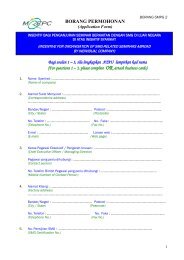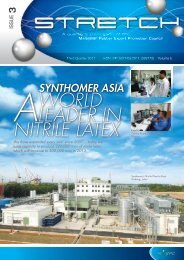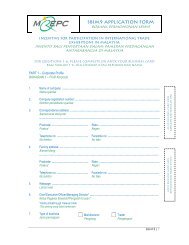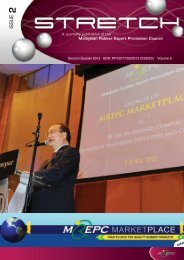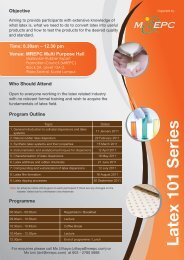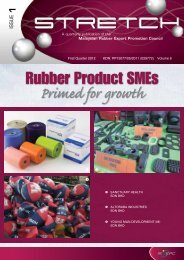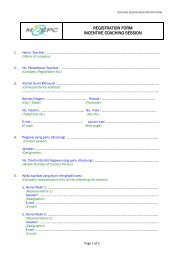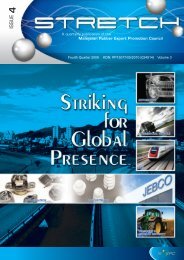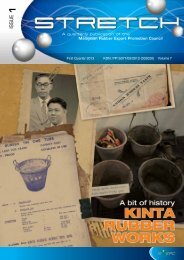Trade Fairs/Exhibitions - Mrepc.com
Trade Fairs/Exhibitions - Mrepc.com
Trade Fairs/Exhibitions - Mrepc.com
You also want an ePaper? Increase the reach of your titles
YUMPU automatically turns print PDFs into web optimized ePapers that Google loves.
○ ○ ○ ○ ○ ○ ○ ○ ○ ○ ○ ○ ○ ○ ○ ○ ○<br />
MREPC’s PRESS RELEASE<br />
IN USA<br />
Published<br />
Studies<br />
Back<br />
Use<br />
of<br />
Latex<br />
Gloves<br />
in<br />
Swine<br />
Flu<br />
Kits<br />
Malaysian Group Says<br />
Washington, DC – May 12 – Amidst measures being taken<br />
to address the swine flu (H1N1 virus) outbreak, Operation<br />
USA and other groups are distributing precautionary kits<br />
that contain face masks and natural rubber latex gloves.<br />
There are many types of gloves on the market, but gloves made from<br />
natural rubber latex are most appropriate to guard against viral<br />
transmissions, according to peer-reviewed, published studies posted at<br />
http://www.latexglove.info/health_safety.php. Natural rubber is also<br />
a renewable resource and biodegradable – unlike synthetic rubber gloves,<br />
which are made from petroleum-derived materials.<br />
Denise Korniewicz, PhD, RN, FAAN, Professor and Sr. Associate Dean<br />
for Research, University of Miami School of Nursing and Health Studies,<br />
is an ac<strong>com</strong>plished researcher and a well-recognized authority on the<br />
barrier integrity of medical gloves. She notes that barrier protection is<br />
paramount during the current swine flu outbreak.<br />
“Although nitrile and vinyl gloves are available for hand protection, latex<br />
gloves still provide the most effective barrier against bacteria and viruses,”<br />
said Dr. Korniewicz. “Vinyl gloves are the least effective. To date, latex<br />
gloves remain the gold standard for barrier protection for healthcare<br />
workers.”<br />
The U.S. Food and Drug Administration's Medical Glove Powder Report<br />
states that there are many gloves made from materials other than latex,<br />
such as synthetic rubbers or polymers, but “none possesses the unique<br />
mix of properties found in NRL (natural rubber latex) gloves." These<br />
properties include high tensile strength and elasticity. The latter property<br />
allows the gloves to reseal holes created from accidental needle pricks,<br />
which often happen in the health care setting.<br />
Latex gloves are produced by countries such as Malaysia, the world's<br />
leading producer of latex and nitrile gloves. All gloves from Malaysia<br />
meet FDA requirements. Quality certified premium latex examination<br />
gloves are also available under the Standard Malaysian Glove (SMG)<br />
program. SMG gloves have controlled low protein levels and are<br />
environmentally friendly. For more information on latex gloves, please<br />
visit www.SMG-online-biz.<br />
Latex is a Proven<br />
○ ○ ○ ○ ○ ○ ○ ○ ○ ○ ○ ○<br />
Barrier Against<br />
○ ○ ○ ○ ○ ○ ○ ○ ○ ○ ○<br />
Viruses and the Only<br />
○ ○ ○ ○ ○ ○ ○ ○ ○ ○ ○ ○ ○ ○ ○<br />
“Green” Option<br />
○ ○ ○ ○ ○ ○ ○ ○ ○ ○ ○ ○<br />
MREPC is a non-profit organization set up by Malaysia. One major role of<br />
MREPC is to serve as an education and information centre focusing<br />
particularly on natural rubber latex gloves to help users better understand<br />
the products they use. The organization works closely with standards setting<br />
and regulatory authorities such as the American Society for Testing and<br />
Materials (ASTM) and the U.S. Food and Drug Administration (FDA), and<br />
with other governmental organizations, and trade, consumer and public<br />
interest groups. For further information about latex gloves, please visit<br />
www.mrepc.<strong>com</strong>.<br />
6



